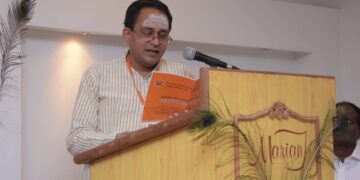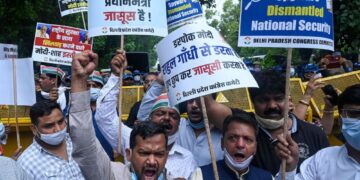 இலங்கைப் படையினரின் இறுதிக்கட்ட தமிழின அழிப்பு போர் நடவடிக்கைக்கு, தாய்லாந்து விமானப் படையினரும் உதவியுள்ளனர் என்ற தகவல் தற்போது வெளிவந்துள்ளது.
இலங்கைப் படையினரின் இறுதிக்கட்ட தமிழின அழிப்பு போர் நடவடிக்கைக்கு, தாய்லாந்து விமானப் படையினரும் உதவியுள்ளனர் என்ற தகவல் தற்போது வெளிவந்துள்ளது.
சிறிலங்காப் படையினர் வன்னியில் மேற்கொண்ட போர் நடவடிக்கைக்கு பன்னாடுகள் சில உதவியளித்திருந்தன.இதில் சில நாடுகள் நேரில் பங்கேற்றும் இருந்தன.
இந்நிலையில் தற்போது, தாய்லாந்து வான்படையினரும் மிகைஒலி தாக்குதல் விமானங்களை அனுப்பி, தமிழின அழிப்பிற்கு உதவியுள்ளளதாக தெரியவந்துள்ளது.
சிறிலங்காப் படையினரின் போர் நடவடிக்கைக்கு இந்தியா, சீனா, பாகிஸ்தான், ரஷ்யா, இஸ்ரல் உள்ளிட்ட பல நாடுகள் உதவியுள்ளதுடன், வான்படையினரின் தாக்குதல் நடவடிக்கைக்கு தாய்லாந்து வான்படையினர் முழுமையான பங்களிப்பினை வழங்கியதாக செய்திகள் தெரிவிக்கின்றன.
வன்னியில் தாக்குதல் நடவடிக்கைக்கு ஈடுபடுத்திய தாய்லாந்து விமானங்கள், தற்போது தாய்லாந்திற்கு கொண்டு செல்லப்பட்டுள்ளன என்று தெரியவந்துள்ளது.











எம் இடம்பெயர்ந்த மக்களின் மீள் தொடரும் அவலங்களை, அவர்களை வைத்து அரசியல் செய்யும் அரசியல்வாதிகள் சிந்திப்பார்களா?
The northern Sri Lankan town of Kilinochchi – former capital of the defeated Liberation Tigers of Tamil Eelam (LTTE) – is struggling to address the needs of thousands of returnees.
According to Sri Lankan military officials, more than 24,000 people or close to 30 percent of the town’s original population have returned since December – many of whom are living in tents.
Aid agencies pulled out of the town in September 2008 as the decades-long conflict intensified.
The Sri Lankan Army successfully captured the political headquarters of the LTTE in Kilinochchi in January 2009.
“This was an unparalleled victory,” President Mahinda Rajapakse said at the time.
“Kilinochchi was the capital of a state dreamt of by a terrorist organization. It will no longer be available to them. We should pay the gratitude of the whole nation to those heroic soldiers who achieved that victory.”
But 10 months since the government declared final victory over the LTTE in May 2009, Kilinochchi is grappling with an influx of returnees.
Before 2008, more than 90,000 people lived in the town, accessible through the strategic A-9 highway than runs between Kandy and Jaffna.
According to military officials from the Sri Lankan 57th Division, the town was completely evacuated during the Kilinochchi offensive, while much of the infrastructure – including schools, hospitals, water and electricity supplies – was badly damaged or destroyed, with nearly 80 percent of all homes affected.
“The Tigers destroyed the town when they were retreating,” a senior military official claimed.
Thousands of residents fled the city en masse in the conflict’s final days, only to find themselves in displaced people’s camps in the town of Vavuniya or elsewhere.
Repairing the damage
But since the government decision to allow residents to return to their places of origin, ensuring quality returns over quantity is also proving a major challenge.
“Lack of proper housing and water facilities is a major problem,” one local aid worker in Kilinochchi, who asked not to be identified, told IRIN.
Many homes were damaged, leaving occupants particularly vulnerable to the southwest monsoon rains, which begin in June and run to October.
“Our makeshift houses lack proper roofs,” Kumari Devarasa, a housewife who resettled last month, told IRIN. “The houses lack basic toilet, water and electricity facilities. It’s a very hard life.”
Residents say the government has provided assistance, including wood, to build and repair their homes, while others continue to live in tents provided by NGOs or have covered their shelters with tarpaulins.
Others still complain about access to health and education.
Livelihood concerns
“We don’t have proper jobs,” Nalini Jabesan. “We live from random amounts/stipends that the government gives us and doing odd jobs.”
David Sivasundaram, a shop owner who resettled last month, described life as “a daily struggle”.
“I don’t think the government has enough money to help us on a large scale,” he said, repairing the war damage to his shop. “Where can they find money?”
“I have many complaints, but right now I don’t want to say this is somebody’s fault. Whatever the situation is, we have to fight ourselves for a better life,” another returnee said.
UN aid agencies are gearing up to assist the government in the resettlement process, including food, emergency education, shelter, health and access to safe drinking water.
According to the UN, more than 185,000 have returned to their homes or are staying with host families since the return process began, while some 93,000 continue to live in camps, the vast majority in and around the town of Vavuniya, northern province.
Courtesy: IRIN
humanitarian news and analysis
a project of the UN Office for the Coordination of Humanitarian Affairs
மாவிலாறில் உயிர் வாழ்வதற்கு அத்தியாவசியமான மானிடர்கள் உட்கொள்ளும் நிறமில்லா தண்ணீரை ஓடவிடாமல் இடைமறித்து, வன்னியில்…. புதுமாத்தலனில் உயிர் வாழ்வதற்கு அத்தியாவசியமான சிவப்பு நிற தண்ணீரை….. குருதியை மானிடத்திலிருந்து பிரித்து மண்ணில் ஓட விட காரணமாக இருந்த மாவிலாற்றின் அணையின் குருசு திருத்தப்பட்ட நிலையில் இவ் குருதியை இழந்த….உயிர் இழந்த….. மானிடர்கள் திரும்ப வருவார்களா?
விபரமான செய்திக்கு:
Mavil Aru revisited
It was the turning point for the nation. When the separatist terrorists – the bloodthirsty LTTE – decided to close the Mavil Aru waterway depriving over 10,000 farmer families in the east water, no responsible government could have looked on impassively at the great human tragedy about to unfold.
It was no surprise for the LTTE terrorists to close the waterway but their gamble to hold the 10,000 farmer families to ransom failed when President Mahinda Rajapaksa decided to attack the terrorists at Mavil Aru chase them out and retake the irrigation scheme. That was the beginning of the end of the terrorist group who did not know anything about irrigation – giving the liquid of life to make people live – but knew another method of making a liquid flow. The red liquid of human blood.
The Mavil Aru sluice gate has been completely repaired and the bridge over the waterway has been built again.
The embankments are also being repaired and up to now 1,000 feet is completed. Farmers and other villagers in the area will be benefited by the scheme within the next few months and after three decades they will be able to cultivate and harvest their rice paddies without fear.
http://www.dailynews.lk/2010/03/25/fea07.asp